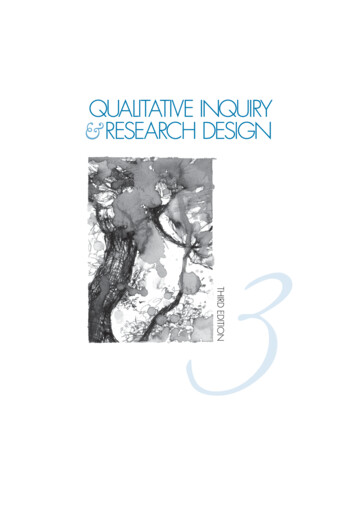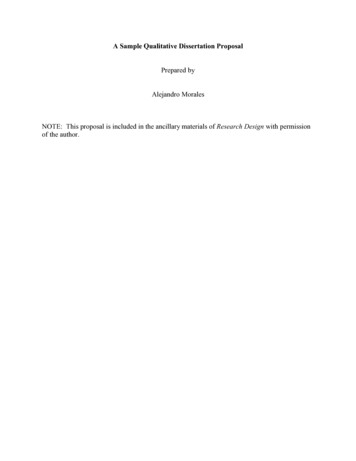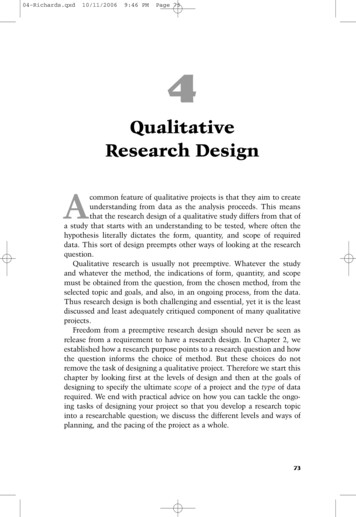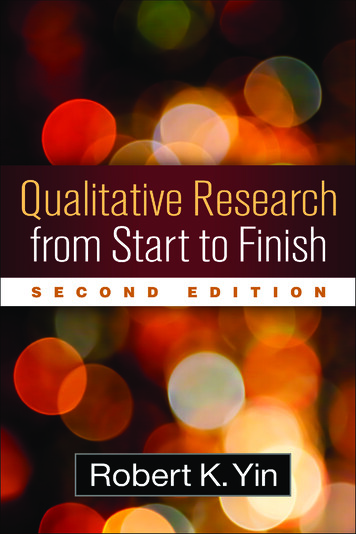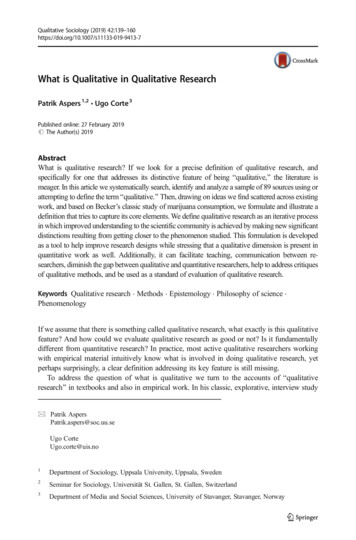
Transcription
Qualitative Sociology (2019) 3-7What is Qualitative in Qualitative ResearchPatrik Aspers 1,2 & Ugo Corte 3Published online: 27 February 2019# The Author(s) 2019AbstractWhat is qualitative research? If we look for a precise definition of qualitative research, andspecifically for one that addresses its distinctive feature of being Bqualitative, the literature ismeager. In this article we systematically search, identify and analyze a sample of 89 sources using orattempting to define the term Bqualitative. Then, drawing on ideas we find scattered across existingwork, and based on Becker’s classic study of marijuana consumption, we formulate and illustrate adefinition that tries to capture its core elements. We define qualitative research as an iterative processin which improved understanding to the scientific community is achieved by making new significantdistinctions resulting from getting closer to the phenomenon studied. This formulation is developedas a tool to help improve research designs while stressing that a qualitative dimension is present inquantitative work as well. Additionally, it can facilitate teaching, communication between researchers, diminish the gap between qualitative and quantitative researchers, help to address critiquesof qualitative methods, and be used as a standard of evaluation of qualitative research.Keywords Qualitative research . Methods . Epistemology . Philosophy of science .PhenomenologyIf we assume that there is something called qualitative research, what exactly is this qualitativefeature? And how could we evaluate qualitative research as good or not? Is it fundamentallydifferent from quantitative research? In practice, most active qualitative researchers workingwith empirical material intuitively know what is involved in doing qualitative research, yetperhaps surprisingly, a clear definition addressing its key feature is still missing.To address the question of what is qualitative we turn to the accounts of Bqualitativeresearch in textbooks and also in empirical work. In his classic, explorative, interview study* Patrik AspersPatrik.aspers@soc.uu.seUgo CorteUgo.corte@uis.no1Department of Sociology, Uppsala University, Uppsala, Sweden2Seminar for Sociology, Universität St. Gallen, St. Gallen, Switzerland3Department of Media and Social Sciences, University of Stavanger, Stavanger, Norway
140Qualitative Sociology (2019) 42:139–160of deviance Howard Becker (1963) asks ‘How does one become a marijuana user?’ In contrastto pre-dispositional and psychological-individualistic theories of deviant behavior, Becker’sinherently social explanation contends that becoming a user of this substance is the result of athree-phase sequential learning process. First, potential users need to learn how to smoke itproperly to produce the Bcorrect effects. If not, they are likely to stop experimenting with it.Second, they need to discover the effects associated with it; in other words, to get Bhigh, individuals not only have to experience what the drug does, but also to become aware that thosesensations are related to using it. Third, they require learning to savor the feelings related to itsconsumption – to develop an acquired taste. Becker, who played music himself, gets close to thephenomenon by observing, taking part, and by talking to people consuming the drug: Bhalf ofthe fifty interviews were conducted with musicians, the other half covered a wide range ofpeople, including laborers, machinists, and people in the professions (Becker 1963:56).Another central aspect derived through the common-to-all-research interplay between induction and deduction (Becker 2017), is that during the course of his research Becker addsscientifically meaningful new distinctions in the form of three phases—distinctions, or findingsif you will, that strongly affect the course of his research: its focus, the material that he collects,and which eventually impact his findings. Each phase typically unfolds through social interaction,and often with input from experienced users in Ba sequence of social experiences during which theperson acquires a conception of the meaning of the behavior, and perceptions and judgments ofobjects and situations, all of which make the activity possible and desirable (Becker 1963:235).In this study the increased understanding of smoking dope is a result of a combination of themeaning of the actors, and the conceptual distinctions that Becker introduces based on the viewsexpressed by his respondents. Understanding is the result of research and is due to an iterativeprocess in which data, concepts and evidence are connected with one another (Becker 2017).Indeed, there are many definitions of qualitative research, but if we look for a definition thataddresses its distinctive feature of being Bqualitative, the literature across the broad field of socialscience is meager. The main reason behind this article lies in the paradox, which, to put it bluntly, isthat researchers act as if they know what it is, but they cannot formulate a coherent definition.Sociologists and others will of course continue to conduct good studies that show the relevance andvalue of qualitative research addressing scientific and practical problems in society. However, ourpaper is grounded in the idea that providing a clear definition will help us improve the work that wedo. Among researchers who practice qualitative research there is clearly much knowledge. Wesuggest that a definition makes this knowledge more explicit. If the first rationale for writing thispaper refers to the Binternal aim of improving qualitative research, the second refers to the increasedBexternal pressure that especially many qualitative researchers feel; pressure that comes both fromsociety as well as from other scientific approaches. There is a strong core in qualitative research, andleading researchers tend to agree on what it is and how it is done. Our critique is not directed at thepractice of qualitative research, but we do claim that the type of systematic work we do has not yetbeen done, and that it is useful to improve the field and its status in relation to quantitative research.The literature on the Binternal aim of improving, or at least clarifying qualitative research islarge, and we do not claim to be the first to notice the vagueness of the term Bqualitative (Straussand Corbin 1998). Also, others have noted that there is no single definition of it (Long andGodfrey 2004:182), that there are many different views on qualitative research (Denzin andLincoln 2003:11; Jovanović 2011:3), and that more generally, we need to define its meaning (Best2004:54). Strauss and Corbin (1998), for example, as well as Nelson et al. (1992:2 cited in Denzinand Lincoln 2003:11), and Flick (2007:ix–x), have recognized that the term is problematic:BActually, the term ‘qualitative research’ is confusing because it can mean different things to
Qualitative Sociology (2019) 42:139–160141different people (Strauss and Corbin 1998:10–11). Hammersley has discussed the possibility ofaddressing the problem, but states that Bthe task of providing an account of the distinctive featuresof qualitative research is far from straightforward (2013:2). This confusion, as he has recentlyfurther argued (Hammersley 2018), is also salient in relation to ethnography where differentphilosophical and methodological approaches lead to a lack of agreement about what it means.Others (e.g. Hammersley 2018; Fine and Hancock 2017) have also identified the treat toqualitative research that comes from external forces, seen from the point of view of Bqualitativeresearch. This threat can be further divided into that which comes from inside academia, suchas the critique voiced by Bquantitative research and outside of academia, including, forexample, New Public Management. Hammersley (2018), zooming in on one type of qualitative research, ethnography, has argued that it is under treat. Similarly to Fine (2003), andbefore him Gans (1999), he writes that ethnography’ has acquired a range of meanings, andcomes in many different versions, these often reflecting sharply divergent epistemologicalorientations. And already more than twenty years ago while reviewing Denzin and Lincoln’ sHandbook of Qualitative Methods Fine argued:While this increasing centrality [of qualitative research] might lead one to believe thatconsensual standards have developed, this belief would be misleading. As the methodology becomes more widely accepted, querulous challengers have raised fundamentalquestions that collectively have undercut the traditional models of how qualitativeresearch is to be fashioned and presented (1995:417).According to Hammersley, there are today Bserious treats to the practice of ethnographic work, onalmost any definition (2018:1). He lists five external treats: (1) that social research must beaccountable and able to show its impact on society; (2) the current emphasis on Bbig data and theemphasis on quantitative data and evidence; (3) the labor market pressure in academia that leavesless time for fieldwork (see also Fine and Hancock 2017); (4) problems of access to fields; and (5)the increased ethical scrutiny of projects, to which ethnography is particularly exposed.Hammersley discusses some more or less insufficient existing definitions of ethnography.The current situation, as Hammersley and others note—and in relation not only to ethnography but also qualitative research in general, and as our empirical study shows—is not justunsatisfactory, it may even be harmful for the entire field of qualitative research, and does nothelp social science at large. We suggest that the lack of clarity of qualitative research is a realproblem that must be addressed.Towards a Definition of Qualitative ResearchSeen in an historical light, what is today called qualitative, or sometimes ethnographic,interpretative research – or a number of other terms – has more or less always existed. Atthe time the founders of sociology – Simmel, Weber, Durkheim and, before them, Marx – werewriting, and during the era of the Methodenstreit (Bdispute about methods ) in which theGerman historical school emphasized scientific methods (cf. Swedberg 1990), we can at leastspeak of qualitative forerunners.Perhaps the most extended discussion of what later became known as qualitative methodsin a classic work is Bronisław Malinowski’s (1922) Argonauts in the Western Pacific, althougheven this study does not explicitly address the meaning of Bqualitative. In Weber’s ([1921–-
142Qualitative Sociology (2019) 42:139–16022] 1978) work we find a tension between scientific explanations that are based on observationand quantification and interpretative research (see also Lazarsfeld and Barton 1982).If we look through major sociology journals like the American Sociological Review,American Journal of Sociology, or Social Forces we will not find the term qualitativesociology before the 1970s. And certainly before then much of what we consider qualitativeclassics in sociology, like Becker’ study (1963), had already been produced. Indeed, theChicago School often combined qualitative and quantitative data within the same study(Fine 1995). Our point being that before a disciplinary self-awareness the term quantitativepreceded qualitative, and the articulation of the former was a political move to claim scientificstatus (Denzin and Lincoln 2005). In the US the World War II seem to have sparked a critiqueof sociological work, including Bqualitative work, that did not follow the scientific canon(Rawls 2018), which was underpinned by a scientifically oriented and value free philosophy ofscience. As a result the attempts and practice of integrating qualitative and quantitativesociology at Chicago lost ground to sociology that was more oriented to surveys andquantitative work at Columbia under Merton-Lazarsfeld. The quantitative tradition was alsoable to present textbooks (Lundberg 1951) that facilitated the use this approach and itsBmethods. The practices of the qualitative tradition, by and large, remained tacit or was partof the mentoring transferred from the renowned masters to their students.This glimpse into history leads us back to the lack of a coherent account condensed in adefinition of qualitative research. Many of the attempts to define the term do not meet therequirements of a proper definition: A definition should be clear, avoid tautology, demarcate itsdomain in relation to the environment, and ideally only use words in its definiens thatthemselves are not in need of definition (Hempel 1966). A definition can enhance precisionand thus clarity by identifying the core of the phenomenon. Preferably, a definition should beshort. The typical definition we have found, however, is an ostensive definition, whichindicates what qualitative research is about without informing us about what it actually is:Qualitative research is multimethod in focus, involving an interpretative, naturalisticapproach to its subject matter. This means that qualitative researchers study things in theirnatural settings, attempting to make sense of, or interpret, phenomena in terms of themeanings people bring to them. Qualitative research involves the studied use and collectionof a variety of empirical materials – case study, personal experience, introspective, life story,interview, observational, historical, interactional, and visual texts – that describe routine andproblematic moments and meanings in individuals’ lives. (Denzin and Lincoln 2005:2)Flick claims that the label Bqualitative research is indeed used as an umbrella for a number ofapproaches (2007:2–4; 2002:6), and it is not difficult to identify research fitting this designation. Moreover, whatever it is, it has grown dramatically over the past five decades. In addition,courses have been developed, methods have flourished, arguments about its future have beenadvanced (for example, Denzin and Lincoln 1994) and criticized (for example, Snow andMorrill 1995), and dedicated journals and books have mushroomed. Most social scientistshave a clear idea of research and how it differs from journalism, politics and other activities.But the question of what is qualitative in qualitative research is either eluded or eschewed.We maintain that this lacuna hinders systematic knowledge production based on qualitativeresearch. Paul Lazarsfeld noted the lack of Bcodification as early as 1955 when he reviewed100 qualitative studies in order to offer a codification of the practices (Lazarsfeld and Barton1982:239). Since then many texts on Bqualitative research and its methods have beenpublished, including recent attempts (Goertz and Mahoney 2012) similar to Lazarsfeld’s.
Qualitative Sociology (2019) 42:139–160143These studies have tried to extract what is qualitative by looking at the large number ofempirical Bqualitative studies. Our novel strategy complements these endeavors by takinganother approach and looking at the attempts to codify these practices in the form of adefinition, as well as to a minor extent take Becker’s study as an exemplar of what qualitativeresearchers actually do, and what the characteristic of being ‘qualitative’ denotes and implies.We claim that qualitative researchers, if there is such a thing as Bqualitative research, shouldbe able to codify their practices in a condensed, yet general way expressed in language.Lingering problems of Bgeneralizability and Bhow many cases do I need (Small 2009)are blocking advancement – in this line of work qualitative approaches are said to differconsiderably from quantitative ones, while some of the former unsuccessfully mimic principlesrelated to the latter (Small 2009). Additionally, quantitative researchers sometimes unfairlycriticize the first based on their own quality criteria. Scholars like Goertz and Mahoney (2012)have successfully focused on the different norms and practices beyond what they argue areessentially two different cultures: those working with either qualitative or quantitativemethods. Instead, similarly to Becker (2017) who has recently questioned the usefulness ofthe distinction between qualitative and quantitative research, we focus on similarities.The current situation also impedes both students and researchers in focusing their studiesand understanding each other’s work (Lazarsfeld and Barton 1982:239). A third consequenceis providing an opening for critiques by scholars operating within different traditions (Valsiner2000:101). A fourth issue is that the Bimplicit use of methods in qualitative research makes thefield far less standardized than the quantitative paradigm (Goertz and Mahoney 2012:9).Relatedly, the National Science Foundation in the US organized two workshops in 2004 and2005 to address the scientific foundations of qualitative research involving strategies toimprove it and to develop standards of evaluation in qualitative research. However, a specificfocus on its distinguishing feature of being Bqualitative while being implicitly acknowledged,was discussed only briefly (for example, Best 2004).In 2014 a theme issue was published in this journal on BMethods, Materials, and Meanings:Designing Cultural Analysis, discussing central issues in (cultural) qualitative research (Berezin2014; Biernacki 2014; Glaeser 2014; Lamont and Swidler 2014; Spillman 2014). We agree withmany of the arguments put forward, such as the risk of methodological tribalism, and that weshould not waste energy on debating methods separated from research questions. Nonetheless, aclarification of the relation to what is called Bquantitative research is of outmost importance toavoid misunderstandings and misguided debates between Bqualitative and Bquantitative researchers. Our strategy means that researchers, Bqualitative or Bquantitative they may be, intheir actual practice may combine qualitative work and quantitative work.In this article we accomplish three tasks. First, we systematically survey the literature formeanings of qualitative research by looking at how researchers have defined it. Drawing uponexisting knowledge we find that the different meanings and ideas of qualitative research are notyet coherently integrated into one satisfactory definition. Next, we advance our contribution byoffering a definition of qualitative research and illustrate its meaning and use partially byexpanding on the brief example introduced earlier related to Becker’s work (1963). We offer asystematic analysis of central themes of what researchers consider to be the core ofBqualitative, regardless of style of work. These themes – which we summarize in terms offour keywords: distinction, process, closeness, improved understanding – constitute part of ourliterature review, in which each one appears, sometimes with others, but never all in the samedefinition. They serve as the foundation of our contribution. Our categories are overlapping.Their use is primarily to organize the large amount of definitions we have identified and
144Qualitative Sociology (2019) 42:139–160analyzed, and not necessarily to draw a clear distinction between them. Finally, we continuethe elaboration discussed above on the advantages of a clear definition of qualitative research.MethodsIn a hermeneutic fashion we propose that there is something meaningful that deserves to belabelled Bqualitative research (Gadamer 1990). To approach the question BWhat is qualitativein qualitative research? we have surveyed the literature. In conducting our survey we firsttraced the word’s etymology in dictionaries, encyclopedias, handbooks of the social sciencesand of methods and textbooks, mainly in English, which is common to methodology courses.It should be noted that we have zoomed in on sociology and its literature. This discipline hasbeen the site of the largest debate and development of methods that can be called Bqualitative, which suggests that this field should be examined in great detail.In an ideal situation we should expect that one good definition, or at least some commonideas, would have emerged over the years. This common core of qualitative research should beso accepted that it would appear in at least some textbooks. Since this is not what we found, wedecided to pursue an inductive approach to capture maximal variation in the field of qualitativeresearch; we searched in a selection of handbooks, textbooks, book chapters, and books, towhich we added the analysis of journal articles. Our sample comprises a total of 89 references.SamplingIn practice we focused on the discipline that has had a clear discussion of methods, namelysociology. We also conducted a broad search in the JSTOR database to identify scholarlysociology articles published between 1998 and 2017 in English with a focus on defining orexplaining qualitative research. We specifically zoom in on this time frame because we wouldhave expect that this more mature period would have produced clear discussions on themeaning of qualitative research. To find these articles we combined a number of keywordsto search the content and/or the title: qualitative (which was always included), definition,empirical, research, methodology, studies, fieldwork, interview and observation.As a second phase of our research we searched within nine major sociological journals(American Journal of Sociology, Sociological Theory, American Sociological Review, Contemporary Sociology, Sociological Forum, Sociological Theory, Qualitative Research, Qualitative Sociology and Qualitative Sociology Review) for articles also published during the past 19 years (1998–2017) that had the term Bqualitative in the title and attempted to define qualitative research.Lastly we picked two additional journals, Qualitative Research and Qualitative Sociology,in which we could expect to find texts addressing the notion of Bqualitative. From QualitativeResearch we chose Volume 14, Issue 6, December 2014, and from Qualitative Sociology wechose Volume 36, Issue 2, June 2017. Within each of these we selected the first article; then wepicked the second article of three prior issues. Again we went back another three issues andinvestigated article number three. Finally we went back another three issues and perused articlenumber four. This selection criteria was used to get a manageable sample for the analysis.CodingThe coding process of the 89 references we gathered in our selected review began soon afterthe first round of material was gathered, and we reduced the complexity created by our
Qualitative Sociology (2019) 42:139–160145maximum variation sampling (Snow and Anderson 1993:22) to four different categories withinwhich questions on the nature and properties of qualitative research were discussed. We call them:Qualitative and Quantitative Research, Qualitative Research, Fieldwork, and Grounded Theory.This – which may appear as an illogical grouping – merely reflects the Bcontext in which thematter of Bqualitative is discussed. If the selection process of the material – books and articles –was informed by pre-knowledge, we used an inductive strategy to code the material. Whenstudying our material, we identified four central notions related to Bqualitative that appear invarious combinations in the literature which indicate what is the core of qualitative research. Wehave labeled them: Bdistinctions , Bprocess, Bcloseness, and Bimproved understanding. Duringthe research process the categories and notions were improved, refined, changed, and reordered.The coding ended when a sense of saturation in the material arose. In the presentation below allquotations and references come from our empirical material of texts on qualitative research.Analysis – What is Qualitative Research?In this section we describe the four categories we identified in the coding, how they differentlydiscuss qualitative research, as well as their overall content. Some salient quotations areselected to represent the type of text sorted under each of the four categories. What we presentare examples from the literature.Qualitative and QuantitativeThis analytic category comprises quotations comparing qualitative and quantitative research, adistinction that is frequently used (Brown 2010:231); in effect this is a conceptual pair thatstructures the discussion and that may be associated with opposing interests. While the generalgoal of quantitative and qualitative research is the same – to understand the world better – theirmethodologies and focus in certain respects differ substantially (Becker 1966:55). Quantity refersto that property of something that can be determined by measurement. In a dictionary of Statisticsand Methodology we find that B(a) When referring to *variables, ‘qualitative’ is another term for*categorical or *nominal. (b) When speaking of kinds of research, ‘qualitative’ refers to studies ofsubjects that are hard to quantify, such as art history. Qualitative research tends to be a residualcategory for almost any kind of non-quantitative research (Stiles 1998:183). But it should beobvious that one could employ a quantitative approach when studying, for example, art history.The same dictionary states that quantitative is Bsaid of variables or research that can behandled numerically, usually (too sharply) contrasted with *qualitative variables and research (Stiles 1998:184). From a qualitative perspective Bquantitative research is about numbers andcounting, and from a quantitative perspective qualitative research is everything that is notabout numbers. But this does not say much about what is Bqualitative. If we turn toencyclopedias we find that in the 1932 edition of the Encyclopedia of the Social Sciencesthere is no mention of Bqualitative. In the Encyclopedia from 1968 we can read:Qualitative Analysis. For methods of obtaining, analyzing, and describing data, see [thevarious entries:] CONTENT ANALYSIS; COUNTED DATA; EVALUATION RESEARCH, FIELD WORK; GRAPHIC PRESENTATION; HISTORIOGRAPHY, especiallythe article on THE RHETORIC OF HISTORY; INTERVIEWING; OBSERVATION;
146Qualitative Sociology (2019) 42:139–160PERSONALITY MEASUREMENT; PROJECTIVE METHODS; PSYCHOANALYSIS,article on EXPERIMENTAL METHODS; SURVEY ANALYSIS, TABULAR PRESENTATION; TYPOLOGIES. (Vol. 13:225)Some, like Alford, divide researchers into methodologists or, in his words, Bquantitative andqualitative specialists (Alford 1998:12). Qualitative research uses a variety of methods, suchas intensive interviews or in-depth analysis of historical materials, and it is concerned with acomprehensive account of some event or unit (King et al. 1994:4). Like quantitative research itcan be utilized to study a variety of issues, but it tends to focus on meanings and motivationsthat underlie cultural symbols, personal experiences, phenomena and detailed understanding ofprocesses in the social world. In short, qualitative research centers on understanding processes,experiences, and the meanings people assign to things (Kalof et al. 2008:79).Others simply say that qualitative methods are inherently unscientific (Jovanović 2011:19).Hood, for instance, argues that words are intrinsically less precise than numbers, and that theyare therefore more prone to subjective analysis, leading to biased results (Hood 2006:219).Qualitative methodologies have raised concerns over the limitations of quantitative templates(Brady et al. 2004:4). Scholars such as King et al. (1994), for instance, argue that nonstatistical research can produce more reliable results if researchers pay attention to the rulesof scientific inference commonly stated in quantitative research. Also, researchers such asBecker (1966:59; 1970:42–43) have asserted that, if conducted properly, qualitative researchand in particular ethnographic field methods, can lead to more accurate results than quantitative studies, in particular, survey research and laboratory experiments.Some researchers, such as Kalof, Dan, and Dietz (2008:79) claim that the boundaries betweenthe two approaches are becoming blurred, and Small (2009) argues that currently much qualitativeresearch (especially in North America) tries unsuccessfully and unnecessarily to emulate quantitative standards. For others, qualitative research tends to be more humanistic and discursive(King et al. 1994:4). Ragin (1994), and similarly also Becker, (1996:53), Marchel and Owens(2007:303) think that the main distinction between the two styles is overstated and does not rest onthe simple dichotomy of Bnumbers versus words (Ragin 1994:xii). Some claim that quantitativedata can be utilized to discover associations, but in order to unveil cause and effect a complexresearch design involving the use of qualitative approaches needs to be devised (Gilbert 2009:35).Consequently, qualitative data are useful for understanding the nuances lying beyond thoseprocesses as they unfold (Gilbert 2009:35). Others contend that qualitative research is particularlywell suited both to identify causality and to uncover fine descriptive distinctions (Fine and Hallett2014; Lichterman and Isaac Reed 2014; Katz 2015).There are other ways to separate these two traditions, including normative statements aboutwhat qualitative research should be (that is, better or worse than quantitative approaches,concerned with scientific approaches to societal change or vice versa; Snow and Morrill 1995;Denzin and Lincoln 2005), or whether it should develop falsifiable statements; Best 2004).We propose that quantitative research is largely concerned with pre-determined variables(Small 2008); the analysis concerns the relations between variables. These categories areprimarily not questioned in the study, only their frequency or degree, or the correlationsbetween them (cf. Franzosi 2016). If a researcher studies wage differences between womenand men, he or she works with given categories: x number of men are co
raphy but also qualitative research in general, and as our empirical study shows—is not just unsatisfactory, it may even be harmful for the entire field of qualitative research, and does not help social science at large. We suggest that the lack of clarity of qualitative re

